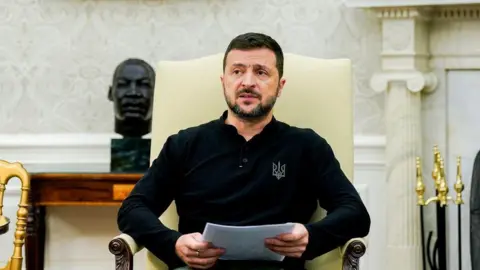Unprecedented Scale of Russian Bombardment
Ukrainian President Volodymyr Zelensky delivered a sobering assessment of Russia’s latest air offensive, disclosing that Ukrainian forces had endured one of the most intense bombardment campaigns since the early days of the invasion. According to military analysts, the past week’s attacks represent a 35% increase in aerial assaults compared to monthly averages from late 2024, signaling a dangerous escalation in Russian tactics as the war enters its fourth year.
The breakdown of weapons deployed paints a chilling picture of modern warfare:
- 1,310 guided aerial bombs: Including the devastating FAB-1500 series with a blast radius of nearly 1 kilometer
- Over 1,000 attack drones: Predominantly Iranian-made Shahed-136 “kamikaze” drones, with newer models showing improved range and payload capacity
- 9 precision missiles: A mix of Iskander ballistic missiles (range 500km) and Kalibr cruise missiles (range 2,500km)
Ukraine’s Air Defense Under Extreme Pressure
Ukrainian air defense units have been operating at maximum capacity, achieving what military experts call “extraordinary” interception rates given the volume of incoming threats. Preliminary data suggests:
- 87% of ballistic missiles intercepted
- 76% of cruise missiles destroyed
- 63% of Shahed drones neutralized
- 41% of guided bombs intercepted or diverted
“These statistics would be impressive for any NATO country,” noted defense analyst Markus Ritter of the European Security Institute. “Ukraine is performing minor miracles with its current air defense inventory.”
However, the non-stop attacks are taking their toll. A senior Ukrainian military official, speaking on condition of anonymity, revealed that:
- Missile defense systems are being pushed beyond recommended operational limits
- Interceptor missile stockpiles are dwindling dangerously low
- Maintenance crews are working 18-hour shifts to keep systems operational
The Human Cost Behind the Numbers
While Zelensky’s announcement focused on military statistics, the human impact of these attacks continues to mount. In Kharkiv alone:
- Residential areas in the Saltivka district were reduced to rubble
- A children’s hospital sustained significant damage
- Emergency services reported 2 confirmed deaths and 17 injuries
- 1,200 residents were left without power for over 24 hours
“These aren’t just numbers – each bomb represents a family’s home destroyed, a business wiped out, a childhood interrupted,” said Kharkiv mayor Ihor Terekhov during a press briefing. “The psychological toll is immeasurable.”
Russia’s Evolving War Strategy

Military analysts identify several troubling trends in Russia’s latest offensive:
- Saturation Tactics: Overwhelming air defenses with sheer volume of attacks
- Precision Strikes: Increasing use of guided munitions against civilian infrastructure
- Psychological Warfare: Deliberate targeting of population centers to erode morale
- Resource Depletion: Designed to exhaust Ukraine’s limited air defense resources
“Putin is playing a long game,” explained Dr. Nataliya Petrova of the Kyiv Institute for Strategic Studies. “He knows Ukraine’s Western-supplied air defenses have finite ammunition. This is a war of attrition in the skies.”
Zelensky’s Urgent Appeal to the West
The Ukrainian president’s message contained both gratitude and a clear warning:
“We thank every nation standing with Ukraine, but words of support won’t stop Russian missiles. We need:
- More Patriot and NASAMS batteries
- Additional F-16 fighter jets
- Expanded production of artillery shells
- Long-range ATACMS missiles
- Accelerated training programs for pilots
The window to act is closing. Every day of delay means more Ukrainian lives lost.”
Read also: Nigeria Police Recruitment 2025: Successful Candidates to Begin Training on April 12
The Geopolitical Stalemate
Western response has been mixed:
- United States: $60 billion aid package remains stalled in Congress
- European Union: Approved €50 billion package but delivery timelines unclear
- United Kingdom: Pledged additional Storm Shadow missiles
- Germany: Committed to delivering third Patriot system by June
“This isn’t just about Ukraine’s survival,” warned NATO Secretary General Jens Stoltenberg. “The security architecture of Europe is at stake. If Putin succeeds here, other authoritarian regimes will be emboldened.”
What Comes Next?
Military experts outline several potential scenarios:
- Russian Spring Offensive: Possible large-scale ground assault timed with air campaign
- Ukrainian Countermeasures: Expanded drone strikes on Russian oil refineries
- Western Breakthrough: Potential delivery of F-16s by summer 2025
- Attrition Warfare: Continued bombardment of Ukrainian cities and infrastructure
The Stakes for Global Security
As the conflict enters a critical phase:
- Global food security remains threatened by Black Sea shipping disruptions
- Energy markets continue to feel ripple effects
- NATO faces its most severe test since the Cold War
- The rules-based international order hangs in the balance
Zelensky’s stark message serves as both a battlefield report and a moral challenge to the Western world. The coming weeks will reveal whether Ukraine receives the tools it needs to defend itself, or if Russian bombardment succeeds in breaking the nation’s will to resist.